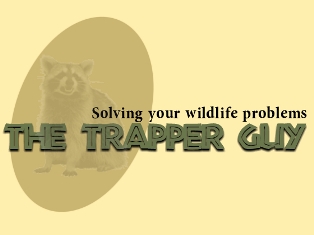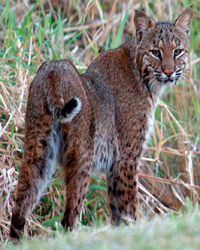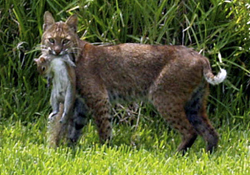| |
|

727-710-0373
Serving
the entire Tampa Bay area
Click
here for a free estimate Bobcats
Bobcats
are located mostly on the edges
of development in Tampa Bay. They
usually don't do well in urban
areas as well as coyotes or raccoons.
If you live near a forested area
or your development has lots of
conservation areas you are likely
to see a bobcat.
Bobcats
are benificial, the help keep
down the rodent population.
Bobcats
can cause most trouble in rural
areas with attacks on poultry,
ducks or small pets kept outdoors.
If
you are having problems with bobcats
The Trapper Guy can help.
Call
today!
727-710-0373
|
FWC
article on Bobcats:
Bobcat
The bobcat (Lynx rufus)
is equipped with razor-sharp claws,
needle-like teeth, and the strength
to make good use of these weapons. The
bobcat is so named because of it's 'bobbed'
tail. This may be a misnomer given that
its tail has been recorded as being
as long as 18 inches. The false perception
that the bobcat has hardly any tail
has given rise to many people thinking
they have seen a panther when they have,
in fact, seen a bobcat.
Bobcats vary in coloration,
but are generally tawny-brown and spotted.
Their undersides are yellowish-white,
spotted with black. The legs are spotted
on the outside and barred with black
on the inside. Bobcats can measure up
to three feet in length, including the
tail, and weigh 15 to 30 pounds. Bobcats
are excellent climbers.
Widely distributed throughout
most of North America, this cat has
adapted well to civilization and is
found throughout Florida. The bobcat
is equally at home in deep forest, swamps,
and hammock land. Thick patches of saw
palmetto and dense shrub thickets are
important as den and resting sites in
Florida. Bobcats can range five or six
square miles and generally cover their
territory in a slow, careful fashion.
The female bobcat can
breed after one year which occurs in
late winter or early spring. In Florida,
bobcats breed from August to March with
the peak in February and March. One
to four young are born after a gestation
period (the period in which offspring
are carried in the uterus) of 50 to
60 days. The average litter size is
two to three kittens, and the young
have mottled or spotted fur with more
distinct facial marking than the adults,
but their eyes do not open until about
nine days old. The young are weaned
in about two months, but not beore they
are taught hunting skills by their parents.
An extremely efficient
hunter, the botcat, like most felines,
hunts by sight and usually at night.
Bobcats will eat just about anything
that moves, but mammals are by far the
most important group of prey animals.
In Florida, the eastern cottontail,
marsh rabbit, cotton rat, and an occasional
young white-tailed deer are the primary
prey species. By feeding on these animals,
the bobcat provides a necessary control
on their populations. Since Florida
is also an important wintering habitat
for migrating birds, the bobcat’s winter
diet reflects this abundance and includes
ground-dwelling birds such as towhees,
robins, catbirds and thrashers.
Most Floridians have
never seen a bobcat, though the fringes
of suburbia continue to move ever closer
to its habitat. Swift and secretive,
hunting mostly at night, bobcats are
the most discreet of neighbors and an
integral part of Florida’s wildlife
community.
The Florida bobcat's
unpredictable disposition does not make
it a popular candidate for a pet. Nor
does its strikingly marked pelt have
much market value. Catching even a fleeting
glimpse of this secretive and beautiful
creature, however, can make anyone's
outdoor experience more enjoyable.
|
|
|

Bobcat
Florida native FWC licensed
nuisance wildlife trapper. Let
me help you with your Bobcat problems.
|
| 
Bobcat
with a squirrel.
|

|
|